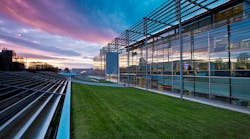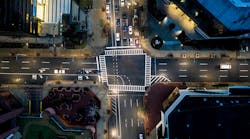“For twelve years, GovEnergy has been providing quintessential training for federal and private sector facility energy professionals. In addition, it provides the opportunity for top rated companies to showcase the latest technologies and capabilities in the energy sector’ says GovEnergy’s Chairman, Commander Brad Hancock, Deputy Director, Facilities Energy Directorate at the Office of the Secretary of Defence.
“The American Recovery and Reinvestment Act (ARRA) of 2009 has provided a much needed investment catalyst for energy projects,” said Hancock, adding that, “GovEnergy will help energy managers make most of these and other investments by providing the finest training available, showcasing the best of new technology and capabilities, and affording exceptional opportunities for professional networking,” adding that he felt that “This (GovEnergy) is a must attend for every facility energy professional.”
With over 100 training sessions taught by nationally recognized experts targeted to Federal energy and facility experts, policies and statutory regulations for federal facilities and operations were emphasized and new energy technologies and management tools were demonstrated.
Market in Motion
Billed as “Charting a Course to Energy Independence” the nautical theme was also relative to a question posed during the “Market in Motion” LED presentation session led by Jim Brodrick, Manager of the US Department of Energy (DOE) Solid State Lighting Program and Mia Paget of Pacific Northwest National Laboratory (PNNL).
The presentation was well attended, with the largest percentage of attendees being potential buyers of LED lighting, a healthy number already engaged in a current or past acquisition. Brodrick explained why the technology is different and outlined the current and future market and DOE resources such as the many programs. Brodrick explained that LED was the last digital frontier to cross, similar to VHS going DVD, jesting with the question, “How many have gone back to VHS’ in comparing this to LED in lighting. Paget’s presentation, “DOE CALiPER: How LED Products Really Perform” detailed the CALiPER program and stressed the rapid improvement and application driven nature of the technology.
Brodrick stressed to proceed with due diligence in reviewing and selecting LED lighting, especially with respect to the multitude of ARRA (stimulus) projects. Both Jim and Mia warned the attendees about ‘versioning’, which was the subject of a recent ‘Postings’ from Jim. Versioning, a relatively new industry term, is where there can be multiple versions of the same product or even collateral in the market due to rapidly changing technology. Mia informed the audience about the new document ‘Understanding Photometric Reports’.
A third presenter on the panel, Andrew Cronin of Nualight, discussed ‘lighting the way to Greener Retail’ and the LED linear fluorescent replacement. As an OEM to refrigeration case manufacturers, this is fine but much confusion still exists about this application as a lighting retrofit and this audience was no different. In both Brodrick’s and Paget’s presentations, they pointed out that this was not a viable application, with respect to efficiency, cost and performance at this time.
In the Q&A, I referred to a recent US Navy project, where the Virginia class attack submarines are being refitted LED lighting in the linear fluorescent form factor (see News). Special purposes such as this may be understandable, due to other considerations, such as breakage, vibration, maintenance and preventing outages in sensitive environments.
Brian Liebel, CEO of After Image + Space gave an interesting presentation about spectrally enhanced lighting, covering such topics as visual acuity, perception and light and human health. Michael Meyer of PNNL joined Liebel on a Lighting Innovations panel.
Other interesting topics included presentations about federal Measurement & Verification guidelines in assessing performance expectations and results. This is very important as the SSL industry encounters this market.
Exhibitors
Over 200 exhibitors showcased the latest in energy and environmental products and services and the event also provided on-site technical tours where attendees observed the latest energy technologies in actual use. LED lighting included products from Acuity Brands, BetaLED, enervation, Hadco, Lightolier, Lithonia, Sol, Solar Electric Power, Solar One and Wesco.
Also present was the DOE Solid State Lighting Program information pavilion, first unveiled at LIGHTFAIR earlier this year. Again, it was a hub of activity with many inquiring minds visiting to acquire further education and information, especially following the DOE / PNNL conference presentation.
I had the opportunity to speak with exhibitors, some with better products than others. There was definitely interest in roadway lighting, some displayed to operate with PV solar off-grid power. I was pleased to have a very interesting conversation with Benjamin Albu, Wesco’s ‘Stimulus Czar’ who has done his research into SSL, especially outdoor lighting products in the sights of municipalities and states. It is refreshing to see when distributors are really in tune with the market and the technology.
Green airport
Of interest and note was the travel through the local airport en route to the event. Providence / Warwick’s T.F. ‘Green’ Airport certainly is acting true to its name. While exiting the gate area on the way to baggage, I noticed that LED PAR replacement lamps had been installed in an exit ramp corridor and upon exiting the airport I also noticed a number of BetaLED Edge series fixtures installed under the roadway in the arrivals area.
Jose DaSilva, Assistant Vice President of Building Maintenance, commented, “The airport conducted an overall energy audit with ConEdison Solutions to determine current usage and then identified opportunities for efficiency and reduction as part of a Energy Saving Performance Contract with a 10 year ROI and a $5 million budget.”
“A decision was made to explore the testing of LED lighting installed by RISE Engineering in conjunction with funding support through rebate subsidies from National Grid, the local utility. The project is in ‘test mode’ and is investigating lifespan and the reduction of lighting maintenance. There are 3 areas being explored: the corridor, the arrivals roadway and an office area using recessed ceiling lighting.” DaSilva also mentioned that LED parking lot lighting is being considered but is dependant upon further funding and utility rebate subsidies.
Government funding
In 2008, the US Federal government spent $23.8 billion in energy expenditures for its facilities, operations, and vehicles. The Energy Policy Act (EPAct) of 2005 Energy Independence Security Act (EISA) of 2007 imposed strict mandates on federal agencies to monitor and reduce their energy consumption. Federal agencies are making significant investments in energy conservation products and services to comply with these mandates.
GovEnergy provides information and training to help federal energy and facility professionals meet their objectives. Further information on GovEnergy 2010, to be held in Dallas, TX from August 15-18, 2010 can be obtained at www.GovEnergy.gov.




